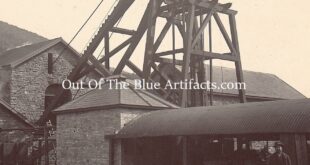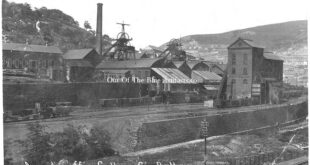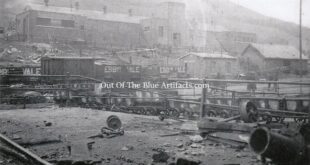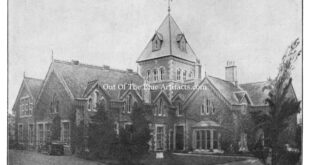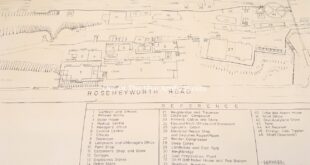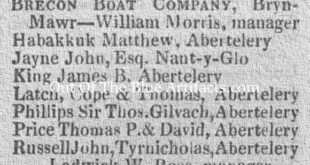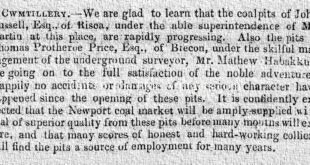Rose Heyworth Colliery Deaths. This list of deaths at the Rose Heyworth Colliery, Abertillery covers most of those reported in National and Local Newspapers. This page is fluid and will be updated as more information is received. 1882. Mr Daniel Hyde, aged 25. Died – August 1882. Cause of death – Mr Hyde tried to cross the pit while the …
Read More »History of the Gwent Collieries
Rose Heyworth Colliery Headgear
Rose Heyworth Colliery Headgear. In March 1875, during the sinking procedure at the Rose Heyworth Colliery, tenders (as seen left) were invited for the construction of a Pithead Frame. A typical pithead frame at this time was a pitch-pine wooden headgear with flat winding rope (as seen in the main featured image above) and rope guides to guide the cage …
Read More »Arrael Griffin Colliery, Six Bells – A History 1891-1988
Arrael Griffin Colliery, Six Bells – A History 1891-1988. Mr John Lancaster Snr. Mr John Lancaster (as seen left) was born in 1816, Lancashire. He had managed many ironworks and collieries in and around Staffordshire and later became chairman of the Wigan Iron and Coal Company, also an M.P. for Wigan. He first came to the valleys in 1877 to …
Read More »Arrael Griffin Colliery, Six Bells – List of Fatalities 1890-1988
Arrael Colliery, Six Bells Colliery – Fatalities 1890-1988. This list of deaths that occurred at the Arrael Griffin Colliery, Six Bells covers most of those reported in National and Local Newspapers. The first deaths occurred during the sinking of the No.4 & No.5 shafts at the colliery and are covered in detail on another page, though they are listed below …
Read More »Rose Heyworth Colliery Pithead Baths – Story
The Pithead Baths Proposal. In March 1929 a proposal was presented to the workers at the Rose Heyworth Colliery to have a pithead baths built for the benefit of the coal miners. In July 1929 a ballot was held to see if the workmen really wanted a pithead baths to be built in the first place and to put forward …
Read More »Mining School – Crumlin
Mining School – Crumlin Monmouthshire. Prior to established mining schools and colleges, the various aspects of advanced mining education in connection with colliery officials and management etc was usually given at local schools in the coal mining districts. These mining classes were usually held after normal school hours under the Technical Instruction Committees. During the rapid expansion of the coal …
Read More »Rose Heyworth Colliery Surface Plan
Rose Heyworth Colliery Surface Plan. Abertillery New Mine – Rose Heyworth Section. Rose Heyworth Colliery surface plan. The one and only original N.C.B. plan. Size 6′ x 2′ foot. Rose Heyworth Colliery and Cwmtillery Colliery had always been connected below ground from the time of the former’s sinking between 1874-75, though in 1959 a new drift was driven between the …
Read More »Mr Matthew Habakkuk – Colliery Owner, Agent and Mining Engineer
Mr Matthew Habakkuk – Colliery Owner, Agent and Mining Engineer. Mr Matthew Habakkuk was born in the 1790’s at Langyfelach, Glamorgan. Some documents have him with differing age. I believe he married a Margaret (no information) she was from the same town Langyfelach, Glamorgan and was born in 1800. An advertisement from the Monmouthshire Merlin newspaper (as seen left) dated …
Read More »Penybont Colliery Sinking Report 1848
Penybont Colliery Sinking Report 1848. A newspaper report from the Principality Newspaper dated Friday 8th of September 1848. It shows the Tyr Nicholas Colliery, Cwmtillery Colliery, progressing. Originally sunk under the ownership of Mr Thomas Brown, purchased by Mr John Russell in 1847 and being expanded under the supervision of Mr Martin of Risca. The report also mentions the progress …
Read More »Shaft Diver – Penybont Colliery 1865
Shaft Diver at the Penybont Tillery Colliery. The following is a report from an engineering item written by Mr T. Dyne Steel, M.E. a shareholder and engineer who had connections with of the Penybont Tillery Colliery in the 1860’s. The Devonshire Journal. This article is from the Devonshire Journal, dated December 1865, it states that Mr T. Dyne Steel has …
Read More » Out Of The Blue Artifacts A Library of a lifetime of collecting
Out Of The Blue Artifacts A Library of a lifetime of collecting

